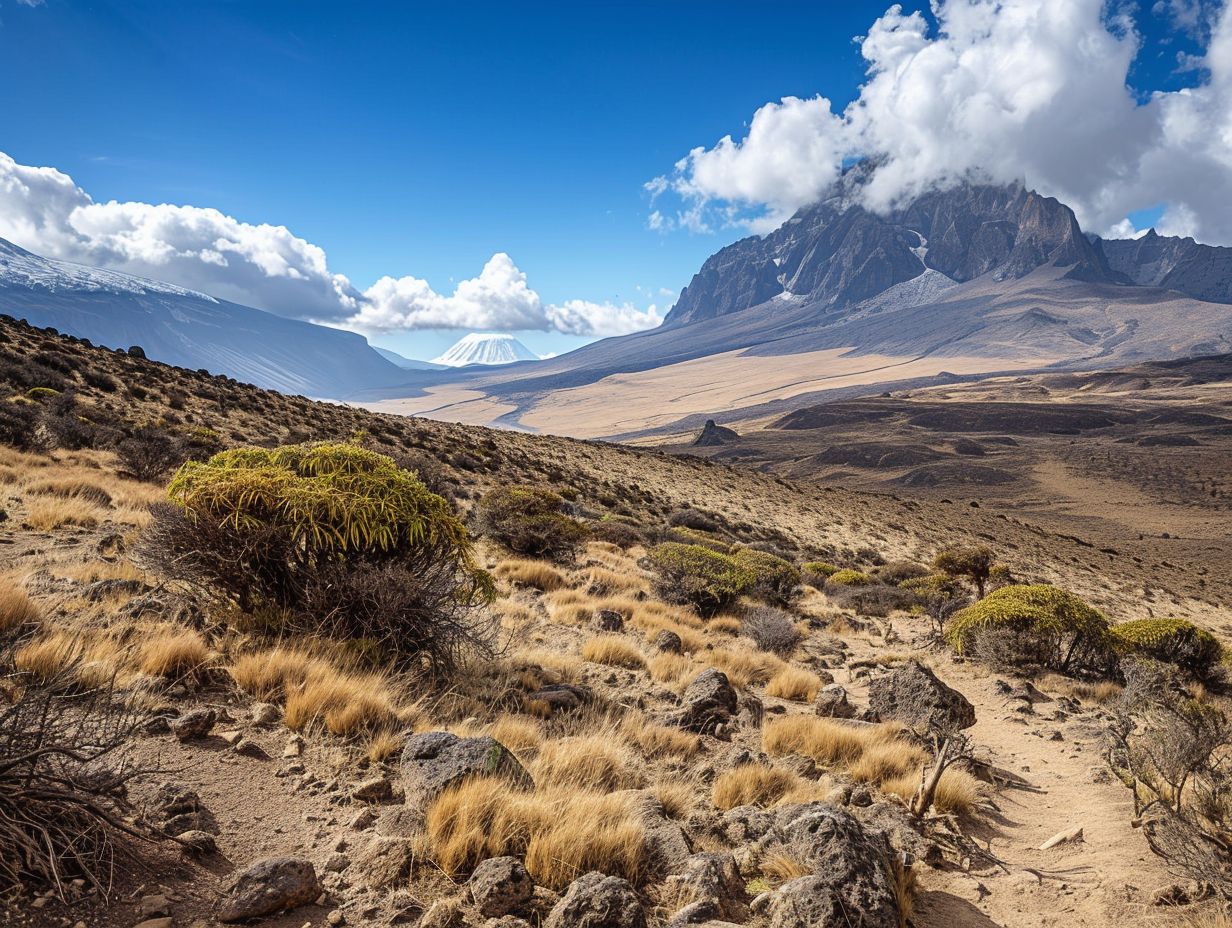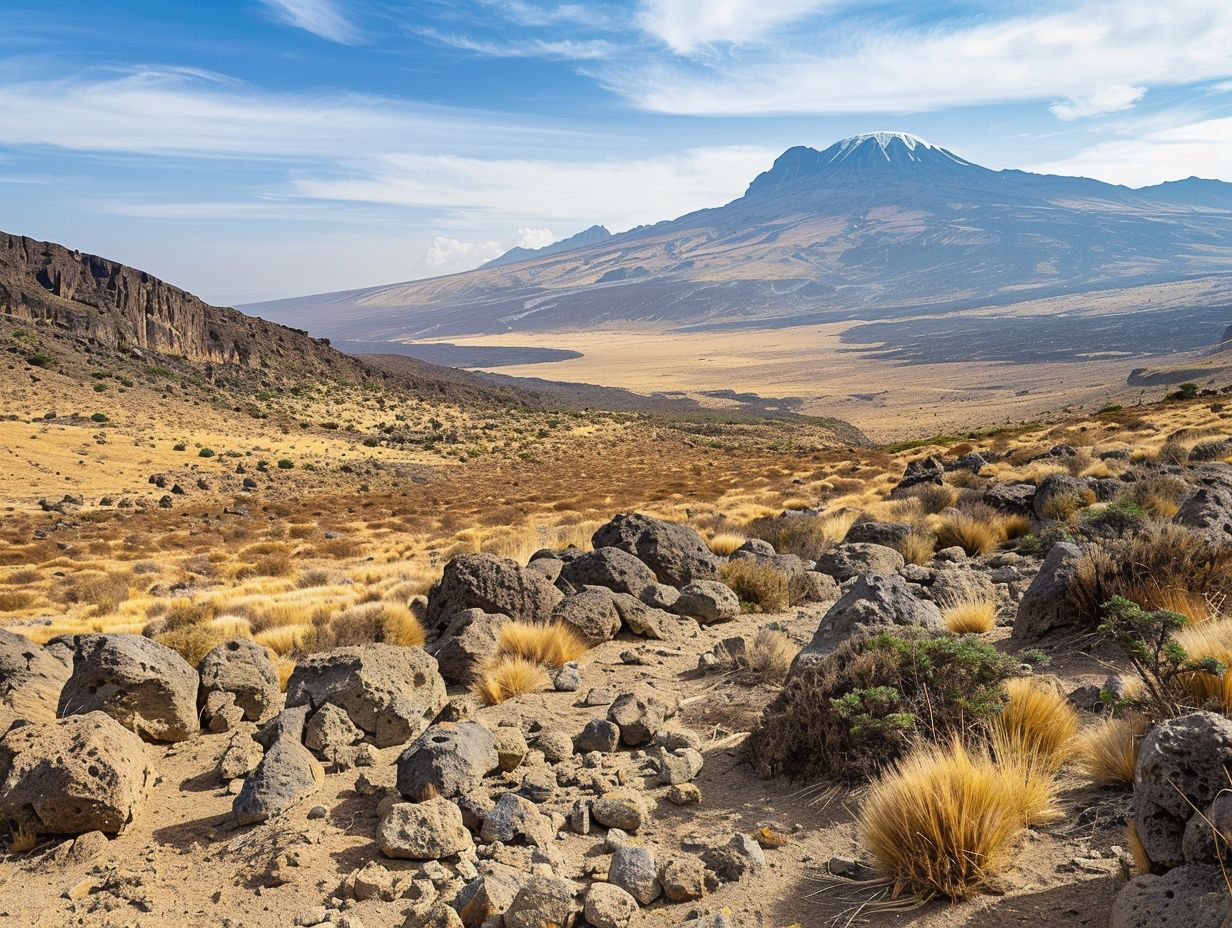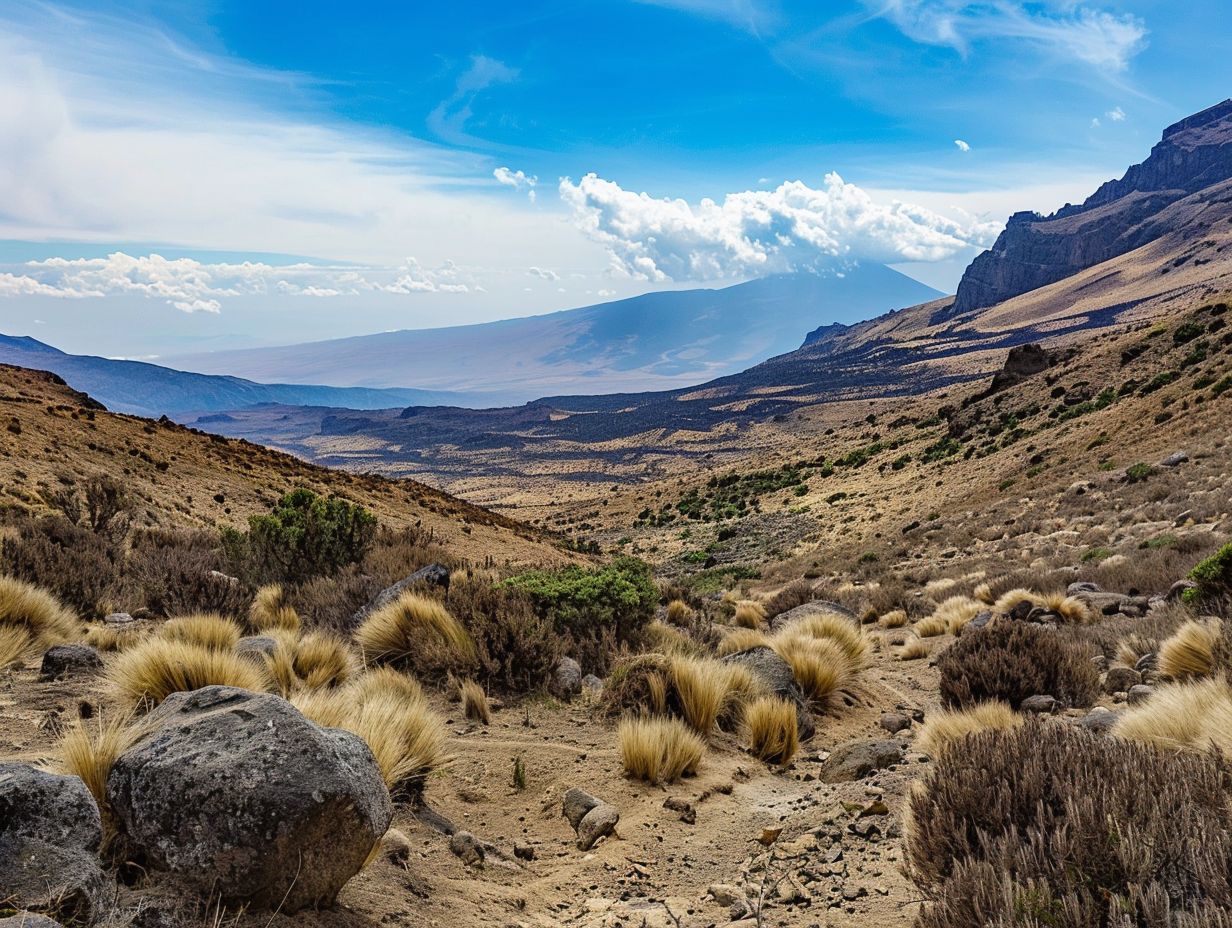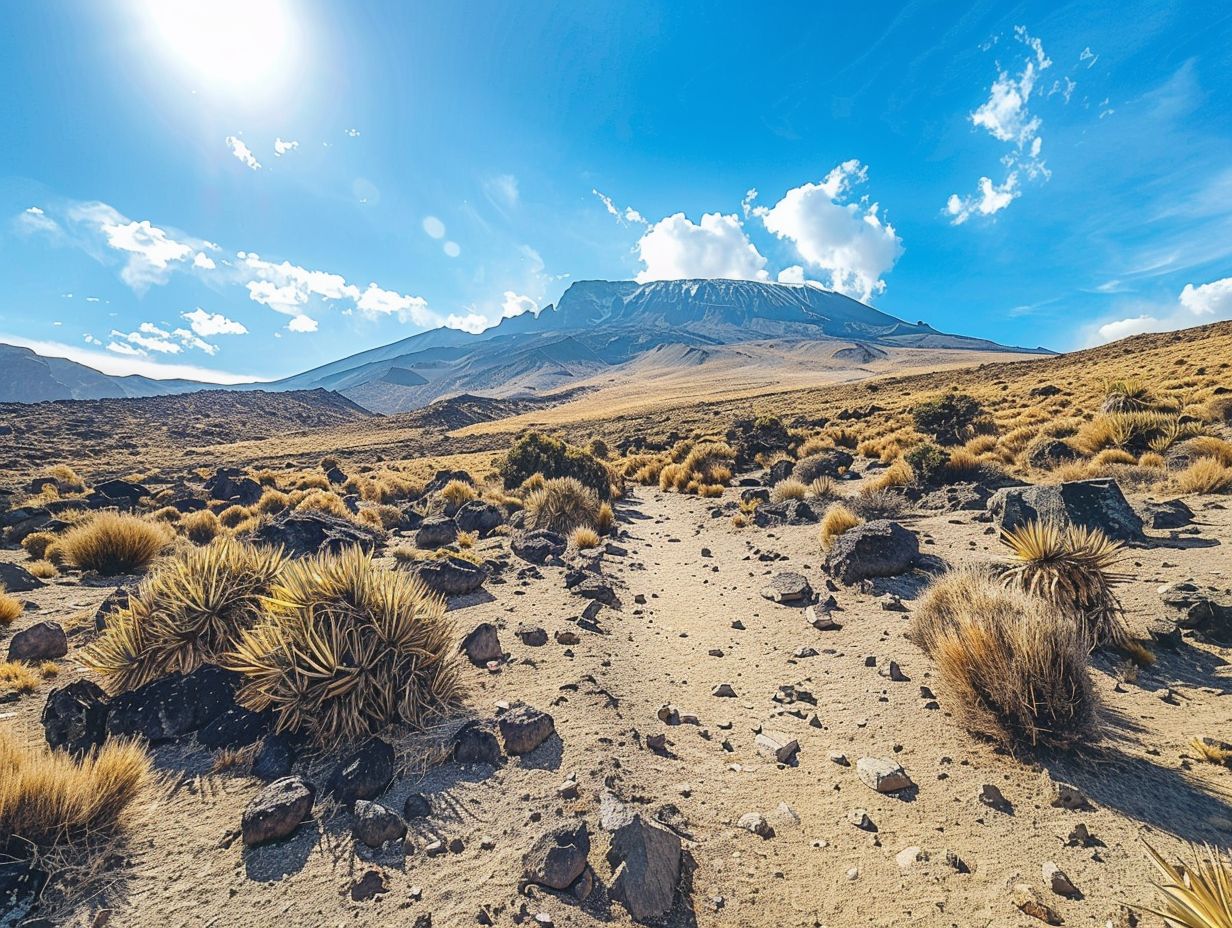
Alpine Desert Zone Kilimanjaro
Have you ever heard of the Alpine Desert Zone on Kilimanjaro? This unique and extreme environment is home to a variety of plants and animals that have adapted to survive in harsh conditions.
The Alpine Desert Zone presents challenges for both climbers and wildlife, from high elevations to low precipitation and extreme temperatures.
In this article, we will explore the characteristics of this zone, the types of plants and animals that call it home, and the impact of climate change on this delicate ecosystem.
So, grab your gear and join us as we journey into the Alpine Desert Zone of Kilimanjaro.
Key Takeaways:

- The Alpine Desert Zone is a high-elevation, arid region located on Mount Kilimanjaro.
- Plants and animals in this zone have unique adaptations to survive extreme temperatures and low precipitation.
- Visitors to the Alpine Desert Zone must take precautions such as proper acclimatization and respect for the environment to safely experience this fragile ecosystem.
What Is the Alpine Desert Zone?
The Alpine Desert Zone on Kilimanjaro is a unique ecological zone characterized by its extreme altitude and sparse vegetation, creating a harsh environment for flora and fauna.
At an altitude of around 4,500 to 5,500 meters above sea level, the specific ecosystem on Kilimanjaro’s Alpine Desert Zone is dominated by rocky terrain and patches of gravelly soil, devoid of large trees due to the lack of nutrients and frost-shattered bedrock.
Temperatures can fluctuate dramatically, ranging from scorching heat during the day to freezing cold nights, posing significant challenges for survival.
The low precipitation levels, often in the form of snow and ice, further add to the harsh conditions, making water scarcity a critical issue for any life forms brave enough to thrive in this zone.
Where Is the Alpine Desert Zone Located?
The Alpine Desert Zone can be found on the slopes of Mount Kilimanjaro in Tanzania, Africa, spanning a specific altitude range where unique climatic conditions prevail.
Located at an elevation of approximately 4,500 to 5,500 meters above sea level, this zone emerges as a stark contrast to the lush greenery found at lower altitudes on the mountain. The Alpine Desert Zone is characterized by its arid landscape, minimal vegetation, and extreme temperature fluctuations.
Due to its high altitude, the Alpine Desert Zone experiences frigid nights and scorching days, with temperatures often dropping below freezing point.
This harsh environment is a result of the altitude, which limits moisture retention and leads to low precipitation levels.
What Are the Characteristics of the Alpine Desert Zone?
The Alpine Desert Zone is distinguished by its high elevation, limited precipitation, and extreme temperature fluctuations, creating a challenging environment for vegetation and wildlife to thrive.
At elevations above 4,500 meters on Kilimanjaro, the Alpine Desert Zone experiences harsh conditions that limit the growth of plants. The thin air and low temperatures hinder plant growth, making it difficult for vegetation to establish deep roots. As a result, the landscape in this zone is often characterized by rocky terrain with sparse vegetation, such as lichens, mosses, and hardy grasses.
The temperature variations in the Alpine Desert Zone can be drastic, ranging from scorching heat during the day to freezing temperatures at night. This extreme climate fluctuation poses a challenge for both plants and animals to adapt and survive in such hostile conditions.
-
High Elevation:
The Alpine Desert Zone’s high elevation on Kilimanjaro contributes to the thin air and low oxygen levels, posing challenges for both plant and animal life in this harsh environment.
At such heights, the reduced oxygen availability forces plant life to adapt creatively to survive. Survival mechanisms include smaller leaf sizes and compact growth forms to minimize water loss, as well as specialized root systems for efficient nutrient absorption. Juniper trees and alpine plants like Edelweiss showcase remarkable resilience in this extreme environment.
Similarly, animals in the Alpine Desert Zone have evolved unique strategies to cope with the altitude. Creatures like the mountain goat have developed larger lung capacities to extract oxygen effectively from the thin air. Migration patterns of animals in search of food and water sources also illustrate the adaptive nature of wildlife in this challenging landscape.
-
Low Precipitation:
The Alpine Desert Zone experiences minimal precipitation levels on Kilimanjaro, leading to arid conditions that challenge the survival of plant species and wildlife in this environment.
Due to the scarcity of water, plant life in the Alpine Desert Zone has developed remarkable adaptations to thrive amidst arid conditions. Succulent plants, such as cacti and agaves, store water in their fleshy tissues to survive long periods without rainfall. Some plants have evolved deep root systems to access underground water sources.
Animals in this region have also adapted to the harsh environment. Species like the Nubian ibex and the mountain gazelle are able to withstand high temperatures and limited water availability by minimizing water loss through efficient cooling mechanisms and behavioral adaptations.
-
Extreme Temperatures:
The Alpine Desert Zone on Kilimanjaro is known for its extreme temperature fluctuations, with scorching daytime heat and freezing nighttime cold posing challenges to the organisms inhabiting this zone.
In such a harsh environment, plants have evolved unique survival strategies to thrive. Succulents store water in their fleshy leaves to withstand long periods of drought during the day, while specialized root systems tap into deep soil moisture reserves. Some plants have adapted small, woolly leaves to reduce water loss and reflect sunlight, preventing overheating.
Animals in this region have also developed remarkable adaptations. Nocturnal creatures burrow underground during the day to escape the heat, emerging at night to forage for food when temperatures are cooler. Others, like the hyrax, have a thick fur coat to insulate against frigid nights.
What Types of Plants and Animals Live in the Alpine Desert Zone?
The Alpine Desert Zone on Kilimanjaro is home to unique plant species such as Senecios and Lobelias, while animal life includes Blue and Colobus monkeys, as well as bird species like the crowned eagle.
In this harsh environment, plants have evolved unique strategies to withstand the extreme conditions prevailing in the Alpine Desert Zone. Adaptations like succulent leaves, reduced surface area, and deep root systems help these plants conserve water and thrive amidst rocky terrain.
Similarly, animals in this zone exhibit remarkable adaptations such as thick fur and specialized behaviors to cope with cold temperatures and scarcity of food. The Blue and Colobus monkeys, for instance, have thick fur coats to retain heat, while bird species like the crowned eagle have keen eyesight to hunt efficiently in the vast open landscapes.
-
Plants:

The plants in the Alpine Desert Zone of Kilimanjaro exhibit unique adaptations to thrive in the arid conditions, with endemic flora like Senecios and Lobelias dominating the sparse landscape.
These remarkable plants have evolved specialized mechanisms to conserve water, such as succulent leaves and stems that store moisture to withstand the harsh environmental conditions. Senecios and Lobelias, with their tall, slender structures and dense rosettes, are perfectly suited to minimize water loss through transpiration.
Their shallow root systems spread widely to capture any available moisture efficiently. This efficient use of resources not only sustains these endemic species but also plays a crucial role in the overall ecosystem stability, providing habitat and food sources for various wildlife species.
-
Animals:
The Alpine Desert Zone hosts a variety of animal species, including Blue and Colobus monkeys, elephants, buffalos, antelopes, and majestic birds like the crowned eagle, showcasing the biodiversity of this unique ecosystem.
These diverse species have evolved remarkable adaptations to survive in the harsh conditions of the Alpine Desert Zone. Blue and Colobus monkeys demonstrate their agility in navigating the rocky terrain, while elephants and buffalos rely on their sheer size and strength to dominate this arid landscape. Antelopes showcase their speed and keen senses, crucial for evading predators in this vast wilderness.
The crowned eagle, with its impressive wingspan and acute vision, reigns over the skies, preying on smaller mammals and birds amidst the rugged peaks. This complex web of interactions among these species highlights the delicate balance of nature in this challenging environment.
What Are the Unique Adaptations of Plants and Animals in the Alpine Desert Zone?
Plants and animals in the Alpine Desert Zone on Kilimanjaro have developed specialized adaptations, such as efficient water retention mechanisms, insulation for thermoregulation, and reduced size to cope with the harsh conditions.
One of the standout features of the flora in this region is the presence of succulent plants like cacti that store water in their fleshy tissues, allowing them to survive long periods without rain.
These plants have evolved to have deep roots that can quickly absorb any moisture available in the sandy soils. The animals in this zone, such as the mountain chamois and the Groundselbush lark, have adapted to the cold nights and scorching days by developing thick fur or feathers for insulation. Some species also exhibit behavioral adaptations like burrowing to escape extreme temperatures.
-
Water Retention Mechanisms:
Plants in the Alpine Desert Zone of Kilimanjaro have evolved effective water retention mechanisms like succulent leaves and deep root systems to withstand the arid conditions and scarcity of water.
These plants have adapted to thrive in a harsh environment where precipitation is scarce and water loss through evaporation is high. Succulent leaves, which store water in their fleshy tissues, enable these plants to endure extended periods of drought by providing a reservoir for hydration. Their deep root systems delve into the soil, tapping into underground water sources that are inaccessible to other vegetation.
This unique adaptation not only ensures the survival of these plants but also plays a crucial role in the ecosystem of the Alpine Desert Zone. By anchoring the soil with their roots and reducing erosion, these plants contribute to the overall stability of the fragile ecosystem. Their ability to store water helps sustain other organisms in the region during dry spells, making them essential components of the local biodiversity.
-
Insulation and Thermoregulation:
Animals in the Alpine Desert Zone rely on insulation through thick fur or feathers and thermoregulation through behavioral adaptations to cope with the temperature extremes on Kilimanjaro.
- Insulation is essential for these animals to retain body heat in the freezing temperatures of the Alpine Desert Zone. Their thick fur or feathers act as a protective layer, trapping warm air close to their bodies and preventing heat loss.
- Thermoregulation strategies play a crucial role in their survival. Animals may seek shelter in rock crevices or burrows during the coldest times of the day and emerge to bask in the sun for warmth when temperatures rise.
- Behavioral adaptations, such as huddling together for warmth or altering activity levels based on temperature fluctuations, help these creatures navigate the challenging climate of Kilimanjaro’s Alpine Desert Zone.
-
Reduced Size and Weight:
Certain animals in the Alpine Desert Zone have evolved smaller body sizes and reduced weight to conserve energy and navigate the challenging terrain of Kilimanjaro more efficiently
These adaptive changes in size and weight reduction play a vital role in the survival of species like the African elephant shrew and rock hyrax. Reduced body mass aids in minimizing heat loss in the extreme cold and arid conditions of the alpine desert, allowing them to retain vital energy reserves for essential activities.
The compact build and lightweight structure of these animals enhance their agility and balance, facilitating swift movements across steep cliffs and rocky surfaces. This efficient locomotion is crucial for evading predators and accessing scattered food resources in the harsh Alpine environment.
How Does Climate Change Affect the Alpine Desert Zone?
Climate change is impacting the Alpine Desert Zone on Kilimanjaro through the accelerated melting of glaciers, disrupting the delicate balance of ecosystems and altering the distribution patterns of plant and animal species.
This transformation is evident in the shrinking size of glaciers which serve as vital water sources for both flora and fauna in this region. As these glaciers retreat, habitats for unique species like the endemic mole rat and diverse plant communities are diminishing, posing significant challenges to their survival.
The cascading effects of habitat loss extend beyond individual species to impact the intricate web of relationships within the ecosystem. The reduction in available resources due to the changing landscape can lead to increased competition for food and shelter, ultimately affecting the overall biodiversity and resilience of the Alpine Desert Zone.
-
Melting Glaciers:
The process of climate change has accelerated the melting of glaciers in the Alpine Desert Zone on Kilimanjaro, leading to water resource challenges and habitat transformations for plants and animals.
This alarming trend has significant implications for the hydrological systems, as the melting glaciers are a crucial source of freshwater for rivers and lakes in the region. As these glaciers shrink, there is a direct impact on the availability of water for irrigation, drinking, and other essential needs, affecting both human populations and wildlife.
The biodiversity of the Alpine Desert Zone is also under threat due to the melting glaciers. Many plant and animal species that are uniquely adapted to the cold environments provided by the glaciers are now facing drastic habitat changes and possible extinction. This disruption in the ecosystem dynamics could lead to cascading effects on the entire food chain, disrupting the delicate balance of the ecosystem.
-
Shifts in Plant and Animal Distributions:

Climate change is causing shifts in plant and animal distributions within the Alpine Desert Zone on Kilimanjaro, leading to altered habitats, food availability, and competition dynamics among species.
As temperatures rise and precipitation patterns evolve, certain plant species are migrating to higher altitudes in search of cooler and more suitable environments. This migration reshapes the landscape, affecting the delicate balance of species interactions. For example, the movement of specific plant species can alter the availability of food sources for certain animals, leading to changes in their foraging behaviors and distribution patterns.
These shifts in vegetation distribution can impact the habitat suitability for various animal species. Animals dependent on certain plant species for food may face challenges as their food sources move or diminish in quantity. This disruption in food availability can not only affect individual species but also trigger cascading effects on the entire ecosystem.
What Are the Challenges of Climbing Kilimanjaro in the Alpine Desert Zone?
Climbing Kilimanjaro and traversing the Alpine Desert Zone pose significant challenges such as altitude sickness due to extreme altitude, unpredictable weather conditions, and limited access to essential resources.
Altitude-related issues are a major concern for climbers tackling Kilimanjaro, as the lack of oxygen at high altitudes can lead to symptoms of altitude sickness, including headaches, nausea, and fatigue. The rapid ascent to the summit increases the risk of altitude sickness, making it vital for climbers to acclimatize properly at various camps along the way.
Weather challenges on Kilimanjaro are equally daunting, with temperatures varying greatly depending on the altitude and time of day. Climbers may encounter intense sun, freezing temperatures, high winds, and even snow, requiring them to be prepared with appropriate gear for all conditions.
Preparation and acclimatization are key factors in a successful Kilimanjaro ascent. Climbers need to train physically, mentally, and logistically to endure the demands of the climb. Proper acclimatization schedules, hydration, and nutrition can significantly reduce the risk of altitude sickness and enhance the chances of reaching the summit safely.
-
Altitude Sickness:
Altitude sickness is a common concern for climbers ascending Kilimanjaro through the Alpine Desert Zone, manifesting as symptoms like headaches, nausea, and fatigue due to reduced oxygen levels at higher altitudes.
When climbers reach elevations above 8,000 feet in the Alpine Desert Zone, the lack of oxygen can lead to more severe forms of altitude sickness, such as High Altitude Pulmonary Edema (HAPE) and High Altitude Cerebral Edema (HACE). These conditions can be life-threatening if not treated promptly.
To combat altitude sickness, climbers are advised to acclimatize gradually, stay well-hydrated, and avoid alcohol and tobacco. Carrying portable oxygen cylinders can provide relief in severe cases.
Understanding the symptoms, taking preventive measures, and respecting the impact of high altitudes on the body are essential for a successful mountain expedition.
-
Extreme Weather Conditions:
The Alpine Desert Zone on Kilimanjaro presents climbers with extreme weather conditions, including scorching heat during the day and freezing temperatures at night, necessitating proper gear and preparation for varying climates.
In the Alpine Desert Zone, temperatures can fluctuate drastically, with daytime highs often exceeding 100°F (37.7°C) and plummeting to near freezing at night. This rapid shift in temperature poses a significant challenge for climbers who must adapt to both extremes to ensure their safety and comfort.
Precipitation patterns in this region are unpredictable, ranging from sporadic rain showers to intense hail storms. Climbers need to be equipped with suitable rain gear and layers to protect themselves from sudden downpours, which can quickly turn the terrain into slippery mud, adding another layer of complexity to the ascent.
Proper clothing and gear are essential in navigating the Alpine Desert Zone, where the right choices can make the difference between an enjoyable climb and a risky venture. From moisture-wicking base layers to insulated jackets and waterproof boots, climbers need to carefully select their attire to stay dry and warm despite the harsh conditions.
-
Limited Resources:
The Alpine Desert Zone on Kilimanjaro presents climbers with limited access to essential resources such as water, shelter, and vegetation, requiring careful planning and resource management during expeditions.
Sustainable practices are vital in such environments to ensure the preservation of these scarce resources for future climbers and the delicate ecosystem. Conservation efforts play a crucial role in maintaining the balance between human exploration and nature’s sustainability.
Containers and filtration systems for water, lightweight and efficient shelters, as well as minimizing waste production become imperative strategies. Managing supplies during mountain climbs demands meticulous organization, factoring in weight constraints and the physical challenges of high altitudes, underscoring the need for strategic planning.
What Are the Precautions for Visiting the Alpine Desert Zone on Kilimanjaro?
Visiting the Alpine Desert Zone on Kilimanjaro requires proper acclimatization to high altitudes, adequate preparation with essential supplies, and a respectful attitude towards the fragile environment to ensure a safe and sustainable experience.
Acclimatization is essential when journeying through the Alpine Desert Zone, where the air thins and oxygen levels decrease. Travelers should allow their bodies time to adjust to the altitude to prevent altitude sickness and ensure an enjoyable adventure. It is crucial to pack appropriate clothing, gear, and provisions for the unique challenges of this harsh environment.
Responsible behavior is key to preserving the delicate ecosystem of the Alpine Desert Zone. Visitors should follow designated trails, avoid disturbing wildlife, and adhere to Leave No Trace principles to minimize their impact. Being mindful of one’s surroundings and observing local guidelines are vital to protecting this pristine wilderness.
-
Proper Acclimatization:
Proper acclimatization is crucial for visitors to the Alpine Desert Zone on Kilimanjaro, allowing the body to adjust to high altitudes gradually and reduce the risk of altitude-related illnesses during the climb.
At high altitudes, the air becomes thinner, leading to lower oxygen levels which can pose challenges to the body. Adequate acclimatization allows for physiological changes like increased red blood cell production, aiding in oxygen transport efficiency.
Climbers are advised to ascend gradually, taking rest days to allow the body to adjust and mitigate altitude sickness. Proper hydration, nutrition, and adequate sleep play pivotal roles in altitude adaptation. Adhering to a well-structured acclimatization schedule is key to a successful summit bid and overall safety on the mountain.
-
Adequate Preparation and Supplies:
Adequate preparation and supplies are essential for travelers venturing into the Alpine Desert Zone on Kilimanjaro, including proper gear, food, water, and emergency medical kits to address any unforeseen challenges during the expedition.
One of the vital factors to consider when preparing for the harsh conditions of the Alpine Desert Zone is the selection of appropriate clothing. Layers are your best friend in this climate, offering versatility as temperatures fluctuate. The use of moisture-wicking fabrics can help regulate body temperature and manage perspiration, preventing overheating and hypothermia. Sturdy hiking boots with good ankle support are crucial for traversing rugged terrain and ensuring stability.
-
Respect for the Environment:

Maintaining respect for the environment is vital when visiting the Alpine Desert Zone on Kilimanjaro, as sustainable practices, waste management, and conservation efforts are crucial to preserving the fragile ecosystem of this unique region.
One key aspect of environmental stewardship in the Alpine Desert Zone is implementing sustainable behaviors during your visit. This involves leaving no trace, properly disposing of waste, and adhering to established guidelines to protect the delicate balance of flora and fauna endemic to this area.
Visitors play a significant role in the conservation of Kilimanjaro by minimizing their impact through eco-friendly practices such as using reusable water bottles, respecting wildlife habitats, and staying on designated trails.
Frequently Asked Questions:
1. What is the Alpine Desert Zone on Kilimanjaro?
A: The Alpine Desert Zone on Kilimanjaro is a high-altitude ecosystem found on the mountain’s upper slopes. It is characterized by rocky terrain, low temperatures, and very little vegetation.
2. What is the climate like in the Alpine Desert Zone on Kilimanjaro?
A: The climate in the Alpine Desert Zone is extremely dry and cold. Temperatures can drop below freezing and there is very little precipitation.
3. What type of plants can be found in the Alpine Desert Zone on Kilimanjaro?
A: Due to the harsh and dry conditions, only a few hardy plants can survive in the Alpine Desert Zone. These include cacti, grasses, and small shrubs.
4. What kind of animals can be found in the Alpine Desert Zone on Kilimanjaro?
A: Some animals that can be found in the Alpine Desert Zone include birds, such as the bar-tailed treecreeper, and small mammals like hyraxes. Larger animals, like elephants and buffalo, can also be spotted passing through the zone on their way to higher elevations.
5. Is it safe to visit the Alpine Desert Zone on Kilimanjaro?
A: While it is generally safe to visit the Alpine Desert Zone, it is important to be prepared for the extreme conditions. Hikers should be in good physical shape and have the appropriate gear, such as warm clothing and plenty of water.
6. How does the Alpine Desert Zone on Kilimanjaro contribute to the mountain’s unique ecosystem?
A: The Alpine Desert Zone is an important part of Kilimanjaro’s ecosystem, as it is one of the key factors that make the mountain a biodiversity hotspot. The unique combination of extreme conditions and diverse flora and fauna make it a fascinating and essential zone to explore.